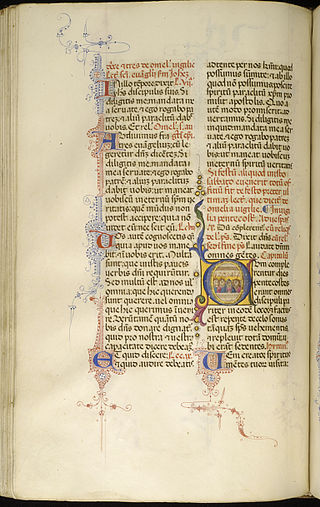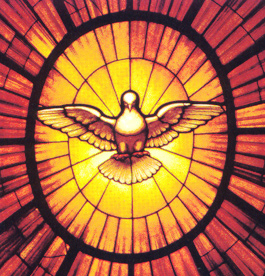
Conditor alme siderum is a seventh-century Latin hymn used during the Christian liturgical season of Advent. [2] It is also known in English as Creator of the Stars of Night, from a translation by J.M. Neale.

Conditor alme siderum is a seventh-century Latin hymn used during the Christian liturgical season of Advent. [2] It is also known in English as Creator of the Stars of Night, from a translation by J.M. Neale.
It was formerly ascribed to Saint Ambrose, but there is no contemporaneous evidence to support the attribution. "This hymn spans all of salvation history, from creation to the end of time when the entire created order will be redeemed and caught up in the life of the Trinity." [3]
The hymn has been mainly used in the Divine Office at Vespers. Because the Christian Church has inherited the Jewish practice of reckoning days from sunset to sunset, many feasts have two Vespers. The feast begins with I Vespers in the evening. [4] In the Sarum Breviary it is appointed as the Vesper hymn on the Saturday before the 1st Sunday in Advent, and throughout Advent on Sundays and week-days when no festival occurs. In the Roman Breviary it is the Vesper hymn in Advent on Sundays, beginning with the Saturday preceding the 1st Sunday in Advent. [5] This is First Vespers, prayed around sunset, with Second Vespers held the same time on Sunday. [6]
The hymn was rewritten by Pope Urban VIII in 1632, changing it so extensively that only the second line of the original hymn remained unchanged. The revision, which begins Creator alme siderum, is thus so extensive that it is in effect a different composition. [7] While the original text did not include a doxology, most versions do include one of some sort, usually appended as verse 6.
John Mason Neale made a translation of the hymn which appeared as "Creator of the Stars of Night" in the first edition of the Hymnal Noted in 1852. [8] The ancient text served as the basis for the text found in the Liturgia Horarum revised in the wake of the Second Vatican Council, where it is indicated for use at Vespers on the First Sunday of Advent. The new text as found in the Antiphonale Romanum II, for Vespers of Sundays and feasts, contains several differences, including the elimination of the Greek word (h)agie in verse 5, due to a correction of the meter, giving Te, Sancte, fide quæsumus instead ("Most holy, faithful One, we beseech thee"). There is also a different doxology than the one found in the appendix to the 1912 Antiphonale Romanum, which contains the ancient texts of the hymns. [9] [10] [11] The doxology is as follows: Sit, Christe, rex piíssime, tibi Patríque glória cum Spíritu Paráclito in sempitérna sæcula (Glory be unto Christ, most gracious King, and to thee, the Father with the Spirit, the Paraclete in the everlasting age).
|
|
|

The Roman Breviary is a breviary of the Roman Rite in the Catholic Church. A liturgical book, it contains public or canonical prayers, hymns, the Psalms, readings, and notations for everyday use, especially by bishops, priests, and deacons in the Divine Office.

Vespers is a liturgy of evening prayer, one of the canonical hours in Catholic, Eastern Orthodox, Oriental Orthodox, and Lutheran liturgies. The word for this prayer time comes from the [vesper, meaning "evening".

In the practice of Christianity, canonical hours mark the divisions of the day in terms of fixed times of prayer at regular intervals. A book of hours, chiefly a breviary, normally contains a version of, or selection from, such prayers.

"Gloria in excelsis Deo" is a Christian hymn known also as the Greater Doxology and the Angelic Hymn/Hymn of the Angels. The name is often abbreviated to Gloria in Excelsis or simply Gloria.

Lauds is a canonical hour of the Divine office. In the Roman Rite Liturgy of the Hours it is one of the major hours, usually held after Matins, in the early morning hours.

The Liturgy of the Hours, Divine Office, or Opus Dei are a set of Catholic prayers comprising the canonical hours, often also referred to as the breviary, of the Latin Church. The Liturgy of the Hours forms the official set of prayers "marking the hours of each day and sanctifying the day with prayer." The term "Liturgy of the Hours" has been retroactively applied to the practices of saying the canonical hours in both the Christian East and West–particularly within the Latin liturgical rites–prior to the Second Vatican Council, and is the official term for the canonical hours promulgated for usage by the Latin Church in 1971. Before 1971, the official form for the Latin Church was the Breviarium Romanum, first published in 1568 with major editions through 1962.

The Office of the Dead or Office for the Dead is a prayer cycle of the Canonical Hours in the Catholic Church, Anglican Church and Lutheran Church, said for the repose of the soul of a decedent. It is the proper reading on All Souls' Day for all departed souls (Purgatory), and can be a votive office on other days when said for a particular decedent. The work is composed of different psalms, scripture, prayers and other parts, divided into The Office of Readings, Lauds, Daytime Prayer, Vespers and Compline.
In the Latin liturgical rites of the Catholic Church, a commemoration is the recital, within the Liturgy of the Hours or the Mass of one celebration, of part of another celebration that is generally of lower rank and impeded because of a coincidence of date.

An antiphonary or antiphonal is one of the liturgical books intended for use in choro, and originally characterized, as its name implies, by the assignment to it principally of the antiphons used in various parts of the Latin liturgical rites.
Acolouthia in the Eastern Orthodox and Eastern Catholic churches, signifies the arrangement of the Divine Services, perhaps because the parts are closely connected and follow in order. In a more restricted sense, the term "acolouth" refers to the fixed portion of the Office. The portions of the Office that are variable are called the Sequences. While the structure and history of the various forms of the Divine Office in the numerous ancient Christian rites is exceedingly rich, the following article will restrict itself to the practice as it evolved in the Eastern Roman (Byzantine) Empire.

The Kyriale is a collection of Gregorian chant settings for the Ordinary of the Mass. It contains eighteen Masses, six Credos, and several ad libitum chants. This collection is included in liturgical books such as the Graduale Romanum and Liber Usualis, and it is also published as a separate book by the monks of Solesmes Abbey.

"Veni Sancte Spiritus", sometimes called the Golden Sequence, is a sequence prescribed in the Roman Liturgy for the Masses of Pentecost and/or its octave, exclusive of the following Sunday. It is usually attributed to either the thirteenth-century Pope Innocent III or to the Archbishop of Canterbury, Cardinal Stephen Langton, although it has been attributed to others as well.

The Ambrosian Rite is a Latin Catholic liturgical Western Rite used in the area of Milan. The Traditional Ambrosian Rite is the form of this rite as it was used before the changes that followed the Second Vatican Council.
Aurora lucis rutilat is the incipit of an Easter hymn of the Latin rite, first recorded in the Frankish Hymnal tradition and preserved in the Benedictine "New Hymnal" . In the numbering introduced by Gneuss (1968), it is no. 41 of the Old Hymnal, and no. 72 of the New Hymnal. The hymn has 12 strophes of 4 verses each as originally recorded;in modern translations it is often reduced to 11 or fewer strophes. The Old High German interlinear version in Bodleian Junius 25 begins Tagarod leohtes lohazit.

"Te Splendor" is a Roman Catholic hymn dedicated to Saint Michael, the Archangel. The hymn derives its name from the fact that in Latin it begins with the words: Te splendor et virtus Patris. The hymn is found in the Roman Breviary.
The Cistercian Hymnal is a compilation of the ancient texts and melodies sung by Cistercian monks and nuns during the Liturgy of the Hours. This collection of hymns influenced the Cistercian Order's identity, since early abbots emphasized the compositions' musical quality. The hymnal developed in the course of the centuries.
Iste confessor is a Latin hymn used in the Divine Office at Lauds and Vespers on feasts of confessors. It exists in two forms. Iste confessor Domini sacratus is the original 8th Century hymn and Iste confessor Domini colentes is a 1632 edition, published by Pope Urban VIII with improved Latin style. The hymn is written in Sapphic and Adonic meter.

"Ye Choirs of New Jerusalem" or "Sing, Choirs of New Jerusalem" is an English Easter hymn by Robert Campbell. It is a 19th-century translation of the medieval Chorus novae Ierusalem, attributed to Fulbert of Chartres. The text's primary focus is the Resurrection of Jesus, taking the theme of Jesus as triumphant victor over death and deliverer of the prisoners from Hell.
Audi benigne Conditor is a Latin hymn used during Lent attributed to Gregory the Great, who reigned as pope from the year 590 until the year 604.

Lucis Creator Optime is a 5th-century Latin Christian hymn variously attributed to St Gregory the Great or Saint Ambrose. It takes its title from its incipit.